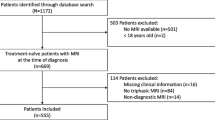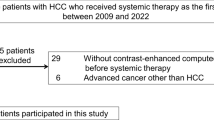Abstract
Background
The measurement of liver volume (LV) is considered to be an effective prognosticator for postoperative liver failure in patients undergoing hepatectomy. It is unclear whether LV can be used to predict mortality in cirrhotic patients.
Methods
We enrolled 584 consecutive cirrhotic patients who underwent computerized topography (CT) of the abdomen for hepatocellular carcinoma surveillance and 50 age, gender, race, and BMI-matched controls without liver disease. Total LV (TLV), functional LV (FLV), and segmental liver volume (in cm3) were measured from CT imaging. Cirrhotic subjects were followed until death, liver transplantation, or study closure date of July 31, 2016. The survival data were assessed with log-rank statistics and independent predictors of survival were performed using Cox hazards model.
Results
Cirrhotic subjects had significantly lower TLV, FLV, and segmental (all except for segments 1, 6, 7) volume when compared to controls. Subjects presenting with hepatic encephalopathy had significantly lower TLV and FLV than those without HE (p = 0.002). During the median follow-up of 1145 days, 112 (19%) subjects were transplanted and 131 (23%) died. TLV and FLV for those who survived were significantly higher than those who were transplanted or dead (TLV:1740 vs. 1529 vs. 1486, FLV 1691 vs. 1487 vs. 1444, p < 0.0001). In the Cox regression model, age, MELD score, TLV, or FLV were independent predictors of mortality.
Conclusion
Baseline liver volume is an independent predictor of mortality in subjects with cirrhosis. Therefore, it may be useful to provide these data while performing routine surveillance CT scan as an important added value. Further studies are needed to validate these findings and to better understand their clinical utility.


Similar content being viewed by others
Abbreviations
- APRI:
-
Aspartate to platelet ratio index
- CT:
-
Computer tomography
- ELF:
-
Enhanced liver fibrosis
- Fib-4:
-
Fibrosis-4
- FLV:
-
Functional liver volume
- LS:
-
Liver stiffness
- MELD:
-
Model for end stage liver disease
- TLV:
-
Total liver volume
References
Zipprich, A., et al., Prognostic indicators of survival in patients with compensated and decompensated cirrhosis. Liver Int, 2012. 32(9): p. 1407-14.
Gines, P., et al., Compensated cirrhosis: natural history and prognostic factors. Hepatology, 1987. 7(1): p. 122-128.
D’Amico, G., G. Garcia-Tsao, and L. Pagliaro, Natural history and prognostic indicators of survival in cirrhosis: a systematic review of 118 studies. J Hepatol, 2006. 44(1): p. 217-31.
Garcia-Tsao, G., Current Management of the Complications of Cirrhosis and Portal Hypertension: Variceal Hemorrhage, Ascites, and Spontaneous Bacterial Peritonitis. Dig Dis, 2016. 34(4): p. 382-6.
Garcia-Tsao, G., et al., Portal hypertensive bleeding in cirrhosis: Risk stratification, diagnosis, and management: 2016 practice guidance by the American Association for the study of liver diseases. Hepatology, 2017. 65(1): p. 310-335.
Siddiqui, M.S., et al., Vibration-controlled Transient Elastography to Assess Fibrosis and Steatosis in Patients With Nonalcoholic Fatty Liver Disease. Clin Gastroenterol Hepatol, 2018.
Kim, B.K., et al., Risk assessment of esophageal variceal bleeding in B-viral liver cirrhosis by a liver stiffness measurement-based model. Am J Gastroenterol, 2011. 106(9): p. 1654-62, 1730.
Berzigotti, A., et al., Elastography, spleen size, and platelet count identify portal hypertension in patients with compensated cirrhosis. Gastroenterology, 2013. 144(1): p. 102-111 e1.
Kim, B.K., et al., Risk assessment of development of hepatic decompensation in histologically proven hepatitis B viral cirrhosis using liver stiffness measurement. Digestion, 2012. 85(3): p. 219-27.
Wang, J., et al., Liver stiffness measurement predicted liver-related events and all-cause mortality: A systematic review and nonlinear dose-response meta-analysis. Hepatol Commun, 2018. 2(4): p. 467-476.
Parkes, J., et al., Enhanced liver fibrosis test can predict clinical outcomes in patients with chronic liver disease. Gut, 2010. 59(9): p. 1245-1251.
Sebastiani, G., et al., Prediction of oesophageal varices in hepatic cirrhosis by simple serum non-invasive markers: Results of a multicenter, large-scale study. J Hepatol, 2010. 53(4): p. 630-8.
Angulo, P., et al., Simple noninvasive systems predict long-term outcomes of patients with nonalcoholic fatty liver disease. Gastroenterology, 2013. 145(4): p. 782-9 e4.
Razek, A., et al., Assessment of the liver and spleen in children with Gaucher disease type I with diffusion-weighted MR imaging. Blood Cells Mol Dis, 2018. 68: p. 139-142.
Razek, A., et al., Apparent diffusion coefficient value of hepatic fibrosis and inflammation in children with chronic hepatitis. Radiol Med, 2014. 119(12): p. 903-909.
Razek, A.A., et al., Prediction of esophageal varices in cirrhotic patients with apparent diffusion coefficient of the spleen. Abdom Imaging, 2015. 40(6): p. 1465-9.
Huber, A., et al., State-of-the-art imaging of liver fibrosis and cirrhosis: A comprehensive review of current applications and future perspectives. Eur J Radiol Open, 2015. 2: p. 90-100.
Smith, A.D., et al., Liver Surface Nodularity Quantification from Routine CT Images as a Biomarker for Detection and Evaluation of Cirrhosis. Radiology, 2016. 280(3): p. 771-81.
Fitzmorris, P. and A.K. Singal, Surveillance and Diagnosis of Hepatocellular Carcinoma. Gastroenterol Hepatol (N Y), 2015. 11(1): p. 38-46.
Kobayashi, K., et al., Screening methods for early detection of hepatocellular carcinoma. Hepatology, 1985. 5(6): p. 1100-5.
Goumard, C., et al., Is computed tomography volumetric assessment of the liver reliable in patients with cirrhosis? HPB (Oxford), 2014. 16(2): p. 188-94.
Lim, M.C., et al., CT volumetry of the liver: where does it stand in clinical practice? Clin Radiol, 2014. 69(9): p. 887-95.
Hagan, M.T., et al., Liver volume in the cirrhotic patient: does size matter? Dig Dis Sci, 2014. 59(4): p. 886-91.
Mokry, T., et al., Accuracy of estimation of graft size for living-related liver transplantation: first results of a semi-automated interactive software for CT-volumetry. PLoS One, 2014. 9(10): p. e110201.
Dunn, W., et al., MELD accurately predicts mortality in patients with alcoholic hepatitis. Hepatology, 2005. 41(2): p. 353-358.
Couinaud, C., The parabiliary venous system. Surg Radiol Anat, 1988. 10(4): p. 311-6.
Zahel, T., et al., Rapid assessment of liver volumetry by a novel automated segmentation algorithm. J Comput Assist Tomogr, 2013. 37(4): p. 577-82.
Mullin, E.J., M.S. Metcalfe, and G.J. Maddern, How much liver resection is too much? Am J Surg, 2005. 190(1): p. 87-97.
Kubota, K., et al., Measurement of liver volume and hepatic functional reserve as a guide to decision-making in resectional surgery for hepatic tumors. Hepatology, 1997. 26(5): p. 1176-81.
Zhu, J.Y., et al., Measurement of liver volume and its clinical significance in cirrhotic portal hypertensive patients. World J Gastroenterol, 1999. 5(6): p. 525-526.
Li, H., et al., Albumin and magnetic resonance imaging-liver volume to identify hepatitis B-related cirrhosis and esophageal varices. World J Gastroenterol, 2015. 21(3): p. 988-96.
Heinemann, A., et al., Standard liver volume in the Caucasian population. Liver Transpl Surg, 1999. 5(5): p. 366-8.
Choi, J.H., et al., Giant hyperplasia of the caudate lobe in a patient with liver cirrhosis: case report and literature review. Gut Liver, 2008. 2(3): p. 205-8.
Volk, M.L., et al., Hospital readmissions among patients with decompensated cirrhosis. Am. J. Gastroenterol, 2012. 107(2): p. 247-252.
Botta, F., et al., MELD scoring system is useful for predicting prognosis in patients with liver cirrhosis and is correlated with residual liver function: a European study. Gut, 2003. 52(1): p. 134-9.
Funding
This work was partly supported by VA Merit Award 1I01CX000361 and NIH R01 AA025208 (to S.L).
Author information
Authors and Affiliations
Contributions
Data collection (MP, PP, MA, SG, and WT), data analysis and interpretation of data (MG, MT, and SL), and manuscript writing, critical review, and corrections (MG, MT, KS, and SL).
Corresponding authors
Ethics declarations
Conflict of interest
The authors declare that they have no conflicts of interest.
Additional information
Publisher's Note
Springer Nature remains neutral with regard to jurisdictional claims in published maps and institutional affiliations.
Electronic supplementary material
Below is the link to the electronic supplementary material.
Rights and permissions
About this article
Cite this article
Patel, M., Puangsricharoen, P., Arshad, H.M.S. et al. Does providing routine liver volume assessment add value when performing CT surveillance in cirrhotic patients?. Abdom Radiol 44, 3263–3272 (2019). https://doi.org/10.1007/s00261-019-02145-6
Published:
Issue Date:
DOI: https://doi.org/10.1007/s00261-019-02145-6




